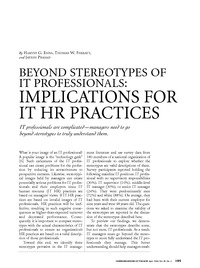 Diese Seite wurde seit 4 Jahren inhaltlich nicht mehr aktualisiert.
Unter Umständen ist sie nicht mehr aktuell.
Diese Seite wurde seit 4 Jahren inhaltlich nicht mehr aktualisiert.
Unter Umständen ist sie nicht mehr aktuell.
 Zusammenfassungen
Zusammenfassungen
IT professionals are complicated---managers need to go beyond stereotypes to truly understand them.
Von Harvey G. Enns, Thomas W. Ferratt, Jayesh Prasad  im Text Beyond stereotypes of IT professionals (2006)
im Text Beyond stereotypes of IT professionals (2006)  Die Autoren vergleichen drei Stereotypen von IT-Professionals mit einer Untersuchung von 180 Mitgliedern eines IT-Professional-Vereins. Dabei kommen Sie zum Schluss, dass die erwähnten Stereotypen nur teilweise zutreffen und Manager von IT-Professionals sich detaillierter mit den Arbeitsmotiven ihrer Mitarbeitenden auseinandersetzen müssen.
Die Autoren vergleichen drei Stereotypen von IT-Professionals mit einer Untersuchung von 180 Mitgliedern eines IT-Professional-Vereins. Dabei kommen Sie zum Schluss, dass die erwähnten Stereotypen nur teilweise zutreffen und Manager von IT-Professionals sich detaillierter mit den Arbeitsmotiven ihrer Mitarbeitenden auseinandersetzen müssen. Bemerkungen
Bemerkungen
 Mir scheint es fraglich, ob Vereinsmitglieder eines Informatikervereins eine gute Grundgesamtheit für eine empirische Untersuchung dieser Art darstellen. Oder einfacher (als Stereotyp) ausgedrückt: Geeks sind tendenziell eher weniger Vereinsmitglieder als Nichtgeeks.
Mir scheint es fraglich, ob Vereinsmitglieder eines Informatikervereins eine gute Grundgesamtheit für eine empirische Untersuchung dieser Art darstellen. Oder einfacher (als Stereotyp) ausgedrückt: Geeks sind tendenziell eher weniger Vereinsmitglieder als Nichtgeeks. Dieser Text erwähnt ...
Dieser Text erwähnt ...
 Zitate aus diesem Text
Zitate aus diesem Text
Stereotype #2: The "old static IT-Professional": According to this stereotype, older IT professionals are radically different from younger IT professionals since they have a lower preference for achievement, specifically career development opportunities . There is a belief that IT professionals who have learned a skill and maintained that skill for years cannot adapt or learn a new one. Consequently, organizations may devote less time and fewer resources toward updating the IT skills of this older group. Taking all of this into consideration, the marketability and job mobility of older IT professionals may be impaired.
von Harvey G. Enns, Thomas W. Ferratt, Jayesh Prasad  im Text Beyond stereotypes of IT professionals (2006)
im Text Beyond stereotypes of IT professionals (2006) Stereotype #3: The "IT-Technology anchored IT-Professional": Consistent with the "technology geek" image, IT professionals define themselves and their value in terms of the number and difficulty of the technical skills they have mastered [8]. Their careers are anchored in technology. Since the half-life of technologies is short, anyone who does not keep up is a dinosaur. Like the dinosaur, these out-ofdate individuals are in danger of becoming extinct, forever severed from the evolving IT career world. According to this third stereotype, moving into a managerial position limits career options since technical competencies erode quickly in such a non-technical position. Therefore, this stereotype views IT professionals as not valuing non-technical/ managerial competencies and assumes management positions are career dead-ends, thus limiting the pool of potential IT managers. In the words of one IT professional who made the transition to manager, "Most of the young-gun technology talent out there say they tolerate the ‘suits’ but have no aspirations to become one".
von Harvey G. Enns, Thomas W. Ferratt, Jayesh Prasad  im Text Beyond stereotypes of IT professionals (2006)
im Text Beyond stereotypes of IT professionals (2006) Stereotype #1: The "High Maintenance" IT Professional: According to this stereotype, IT professionals provide significant value to their organizations, but they expect their organizations to meet their many needs. Expectations of these high achievers include more pay, benefits, interesting work, recognition, and opportunities for growth and development. These IT professionals define more interesting work as the opportunity to work on hot projects with the latest and greatest information technology. They spend long hours, preferably at their time and place of choice, learning new technologies and determining how to make systems work. Nonetheless, they want the organization to provide them with training and new technologies to help them keep current. They want to be challenged to make great things happen with these technologies and to be appreciated for their contributions. Fundamentally, the character of this stereotype is consistent with research showing that high performers are motivated by specific challenging goals and feedback [3, 5] and that IT professionals have a high need for growth and development [2].
von Harvey G. Enns, Thomas W. Ferratt, Jayesh Prasad  im Text Beyond stereotypes of IT professionals (2006) auf Seite 106
im Text Beyond stereotypes of IT professionals (2006) auf Seite 106 Anderswo finden
Anderswo finden
 Volltext dieses Dokuments
Volltext dieses Dokuments
 |  Beyond stereotypes of IT professionals: Artikel als Volltext ( Beyond stereotypes of IT professionals: Artikel als Volltext ( : :  , 100 kByte; , 100 kByte;  : :  2020-11-28) 2020-11-28) |
 Anderswo suchen
Anderswo suchen 
 Beat und dieser Text
Beat und dieser Text
Beat war Co-Leiter des ICT-Kompetenzzentrums TOP während er Dieser Text ins Biblionetz aufgenommen hat. Die bisher letzte Bearbeitung erfolgte während seiner Zeit am Institut für Medien und Schule. Beat besitzt kein physisches, aber ein digitales Exemplar. Eine digitale Version ist auf dem Internet verfügbar (s.o.). Aufgrund der wenigen Einträge im Biblionetz scheint er es nicht wirklich gelesen zu haben. Es gibt bisher auch nur wenige Objekte im Biblionetz, die dieses Werk zitieren.











 Geek
Geek Management
Management Motivation
Motivation
 Biblionetz-History
Biblionetz-History